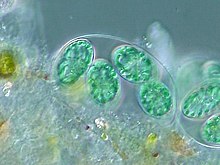Loading AI tools
Division of algae From Wikipedia, the free encyclopedia
The glaucophytes, also known as glaucocystophytes or glaucocystids, are a small group of unicellular algae found in freshwater and moist terrestrial environments,[1][2] less common today than they were during the Proterozoic.[3] The stated number of species in the group varies from about 14 to 26.[4][5][6] Together with the red algae (Rhodophyta) and the green algae plus land plants (Viridiplantae or Chloroplastida), they form the Archaeplastida.
| Glaucophyta | |
|---|---|
 | |
| Glaucocystis sp. | |
| Scientific classification | |
| Clade: | Archaeplastida |
| Division: | Glaucophyta Skuja 1948 |
| Class | |
| |
| Synonyms | |
| |
The glaucophytes are of interest to biologists studying the evolution of chloroplasts as they may be similar to the original algal type that led to the red algae and green plants, i.e. glaucophytes may be basal Archaeplastida.[1][7][4]
Unlike red and green algae, glaucophytes only have asexual reproduction.[8]
The plastids of glaucophytes are known as 'muroplasts',[9] 'cyanoplasts', or 'cyanelles'. Unlike the plastids in other organisms, they have a peptidoglycan layer, believed to be a relic of the endosymbiotic origin of plastids from cyanobacteria.[1][10] Glaucophytes contain the photosynthetic pigment chlorophyll a.[1] Along with red algae[1] and cyanobacteria, they harvest light via phycobilisomes, structures consisting largely of phycobiliproteins. The green algae and land plants have lost that pigment.[11] Like red algae, and in contrast to green algae and plants, glaucophytes store fixed carbon in the cytosol.[12]
The most early-diverging genus is Cyanophora, which only has one or two plastids. When there are two, they are semi-connected.[13]
Glaucophytes have mitochondria with flat cristae, and undergo open mitosis without centrioles. Motile forms have two unequal flagella, which may have fine hairs and are anchored by a multilayered system of microtubules, both of which are similar to forms found in some green algae.[11]

Together with red algae and Viridiplantae (green algae and land plants), glaucophytes form the Archaeplastida – a group of plastid-containing organisms that may share a unique common ancestor that established an endosymbiotic association with a cyanobacterium. The relationship among the three groups remains uncertain, although it is most likely that glaucophytes diverged first:[4]
| Archaeplastida |
| ||||||
The alternative, that glaucophytes and red algae form a clade, has been shown to be less plausible, but cannot be ruled out.[4]
The internal phylogeny of the glaucophytes and the number of genera and species varies considerably among taxonomic sources. A phylogeny of the Glaucophyta published in 2017 divided the group into three families, and includes five genera:[14]
| Glaucophyta |
| ||||||||||||||||||||||||
A 2019 list of the described glaucophyte species has the same three subdivisions, treated as orders, but includes a further five unplaced possible species, producing a total of between 14 and 19 possible species.[4]
As of March 2022[update], AlgaeBase divided glaucophytes into only two groups, placing Cyanophora in Glaucocystales rather than Cyanophorales (however the entry was dated 2011).[15] AlgaeBase included a total of 26 species in nine genera:[16]
None of the species of Glaucophyta is particularly common in nature.[1]
The glaucophytes were considered before as part of family Oocystaceae, in the order Chlorococcales.[17]
Seamless Wikipedia browsing. On steroids.
Every time you click a link to Wikipedia, Wiktionary or Wikiquote in your browser's search results, it will show the modern Wikiwand interface.
Wikiwand extension is a five stars, simple, with minimum permission required to keep your browsing private, safe and transparent.